


| MOQ: | 1kg |
| Price: | US $2/kg |
| Standard Packaging: | Cylinder/Tank |
| Delivery Period: | 15 days |
| Payment Method: | L/C, T/T |
| Supply Capacity: | 50000kg/month |
Ethylene gas (C2H4) is a colorless, flammable gas that is widely used in various industrial and agricultural applications. It is an important plant hormone and is also produced industrially for its versatile properties. Here are some key points about ethylene gas:
Properties: Ethylene gas possesses several notable properties:
Flammability: Ethylene is a highly flammable gas that can form explosive mixtures with air. It has a lower flammability limit (LFL) of 2.7% and an upper flammability limit (UFL) of 36%.
Odor: Pure ethylene gas is odorless. However, commercial-grade ethylene often contains impurities that give it a slightly sweet or garlic-like odor.
Density: Ethylene gas is slightly lighter than air, so it tends to rise and disperse in the atmosphere.
Production: Ethylene gas is primarily produced through the steam cracking of hydrocarbon feedstocks, such as natural gas, naphtha, or ethane. The feedstock is heated to high temperatures, causing the carbon-carbon bonds to break and yielding a mixture of hydrocarbon gases, including ethylene.
Uses: Ethylene gas has numerous industrial and agricultural applications:
Petrochemical Industry: Ethylene is a key building block for the petrochemical industry. It is used as a raw material in the production of various chemicals, including polyethylene (the most common plastic), ethylene oxide, ethylene glycol, vinyl chloride, and more.
Agriculture: Ethylene is used in agriculture to regulate the ripening of fruits and the senescence (aging) of flowers. It is employed in controlled environments to accelerate the ripening process of certain fruits, such as bananas, tomatoes, and avocados.
Plant Hormone: Ethylene acts as a plant hormone and plays a crucial role in several physiological processes, including fruit ripening, flower opening, leaf senescence, and responses to stress, such as pathogen attack or mechanical damage.
Welding: Ethylene gas can be used as a fuel gas in oxyfuel welding and cutting processes, although it is less common than acetylene.
Safety Considerations: Ethylene gas is flammable and should be handled with caution. Some safety considerations include:
Storage and Handling: Ethylene gas should be stored in appropriate containers or cylinders designed for flammable gases. It should be handled in well-ventilated areas, away from ignition sources and heat.
Fire Hazards: Ethylene gas can form explosive mixtures with air. Proper measures should be taken to prevent the accumulation of flammable concentrations and minimize the risk of ignition.
Toxicity: Ethylene gas itself is not highly toxic. However, it can displace oxygen in confined spaces, leading to an oxygen-deficient environment. Adequate ventilation is crucial when working with ethylene gas.
Basic Info.
| Model No: | C2H4 | Transport Package | Cylinder |
| Specification: | 40L | Trademark | CMC |
| Origin: | Suzhou | HS Code | 2812190091 |
| Production Capacity: | 5000 Tons Per Month |
Specification:
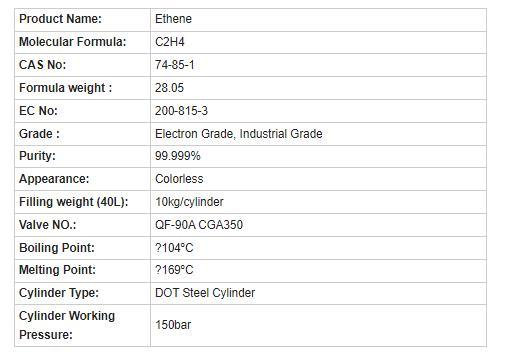
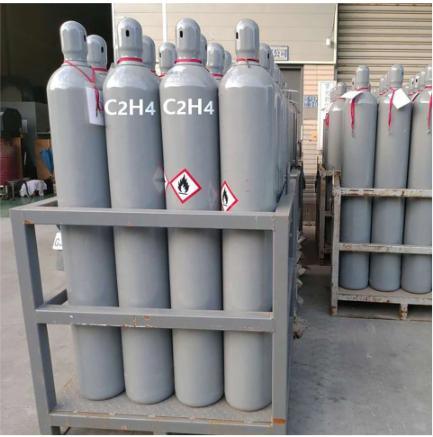
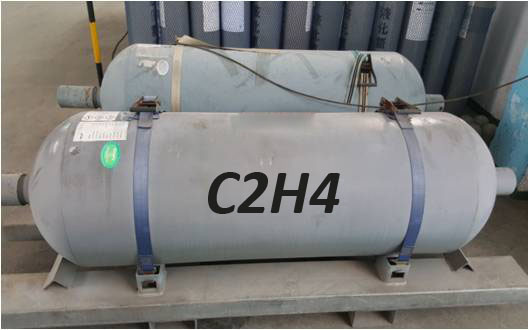
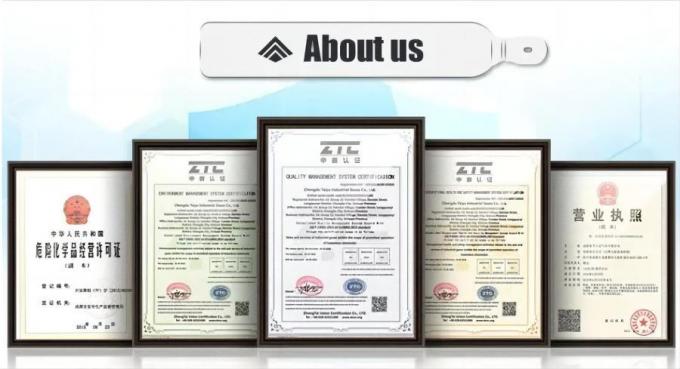

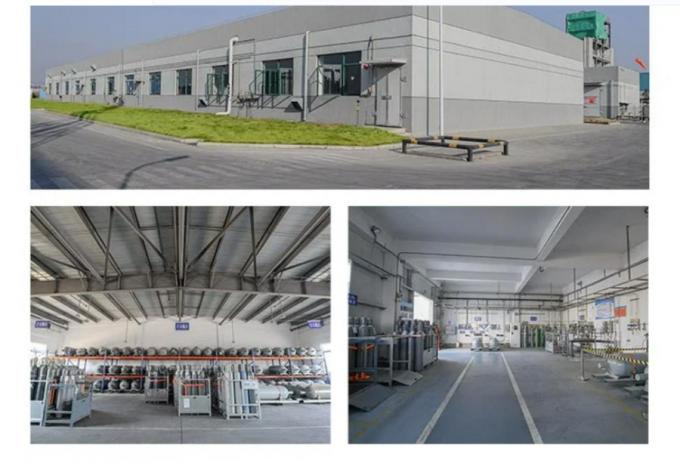

| MOQ: | 1kg |
| Price: | US $2/kg |
| Standard Packaging: | Cylinder/Tank |
| Delivery Period: | 15 days |
| Payment Method: | L/C, T/T |
| Supply Capacity: | 50000kg/month |
Ethylene gas (C2H4) is a colorless, flammable gas that is widely used in various industrial and agricultural applications. It is an important plant hormone and is also produced industrially for its versatile properties. Here are some key points about ethylene gas:
Properties: Ethylene gas possesses several notable properties:
Flammability: Ethylene is a highly flammable gas that can form explosive mixtures with air. It has a lower flammability limit (LFL) of 2.7% and an upper flammability limit (UFL) of 36%.
Odor: Pure ethylene gas is odorless. However, commercial-grade ethylene often contains impurities that give it a slightly sweet or garlic-like odor.
Density: Ethylene gas is slightly lighter than air, so it tends to rise and disperse in the atmosphere.
Production: Ethylene gas is primarily produced through the steam cracking of hydrocarbon feedstocks, such as natural gas, naphtha, or ethane. The feedstock is heated to high temperatures, causing the carbon-carbon bonds to break and yielding a mixture of hydrocarbon gases, including ethylene.
Uses: Ethylene gas has numerous industrial and agricultural applications:
Petrochemical Industry: Ethylene is a key building block for the petrochemical industry. It is used as a raw material in the production of various chemicals, including polyethylene (the most common plastic), ethylene oxide, ethylene glycol, vinyl chloride, and more.
Agriculture: Ethylene is used in agriculture to regulate the ripening of fruits and the senescence (aging) of flowers. It is employed in controlled environments to accelerate the ripening process of certain fruits, such as bananas, tomatoes, and avocados.
Plant Hormone: Ethylene acts as a plant hormone and plays a crucial role in several physiological processes, including fruit ripening, flower opening, leaf senescence, and responses to stress, such as pathogen attack or mechanical damage.
Welding: Ethylene gas can be used as a fuel gas in oxyfuel welding and cutting processes, although it is less common than acetylene.
Safety Considerations: Ethylene gas is flammable and should be handled with caution. Some safety considerations include:
Storage and Handling: Ethylene gas should be stored in appropriate containers or cylinders designed for flammable gases. It should be handled in well-ventilated areas, away from ignition sources and heat.
Fire Hazards: Ethylene gas can form explosive mixtures with air. Proper measures should be taken to prevent the accumulation of flammable concentrations and minimize the risk of ignition.
Toxicity: Ethylene gas itself is not highly toxic. However, it can displace oxygen in confined spaces, leading to an oxygen-deficient environment. Adequate ventilation is crucial when working with ethylene gas.
Basic Info.
| Model No: | C2H4 | Transport Package | Cylinder |
| Specification: | 40L | Trademark | CMC |
| Origin: | Suzhou | HS Code | 2812190091 |
| Production Capacity: | 5000 Tons Per Month |
Specification:





